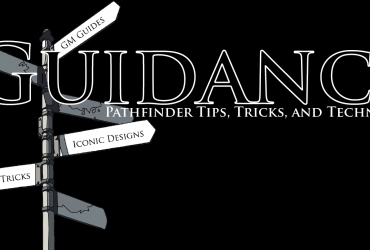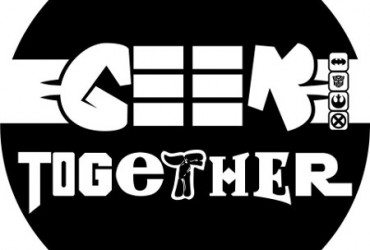Welcome to Guidance, Private Sanctuary’s source for tips and techniques for the Pathfinder Roleplaying Game, written by Everyman Gamer Alexander Augunas. Today, we’re going to be talking about my Top 10 Favorite Hybrid Class archetypes.
A few weeks ago I did a blog article talking about my Top 10 favorite archetypes for the core classes and base classes in Pathfinder RPG Advanced Class Guide. Today I’m going to do a second Top 10 list, but this time it’ll be for archetypes designed for the new hybrid classes. Also remember that for me, “favorite” and “most powerful” and are not the same thing, and as a matter of fact if an archetype seems too powerful, then I’m probably not going to like it. Without further hesitation, let’s dive on into this topic!
Blade Adept (Arcanist)
I actually predicted that the arcanist was going to get a black blade archetype when Jason Bulhman announced this archetype way back in July, and I was happy to see that I was right. Furthermore, I was even more happy to see a class that was extremely multiclassing friendly. In addition to giving the arcanist a black blade, the class is almost specifically designed to pick up a prestige class such as eldritch knight or arcane trickster. (Both are very good for this class.) In the future I want to play with some blade adept builds, but for now you’ll have to trust me that this is a neat archetype with a lot of potential thanks to its eldritch blade arcana.
White Mage (Arcanist)
It has taken us (Pathfinder players) a LONG time to get an arcane spellcaster who is at least someone proficient at healing. I’m happy to finally have this archetype in the arcanist’s white mage class. Because you can only cast healing magic with your arcane reservoir, this archetype seems deceptively weak. In practice, however, the consume magic items exploit allows an arcanist to constantly chug away at wands, scrolls, and similar spell trigger magic items to quickly recharge points, allowing the arcanist to do a decent job at fulfilling two entirely separate party roles. Not only is this a much-needed archetype, but its also a darn good one too.
Rageshaper (Bloodrager)
I’m a bit fan of transmutation-type options, and rageshaper is pretty good at that. This archetype enhances the bloodrager’s abilities earned from polymorph effects, likely to compensate for its rather low spell progression. This archetype is extremely potent when combined with bloodlines that grant spells, however, such as the draconic bloodline’s 16th level ability that transforms the bloodrager into a dragon while raging. (AWESOME!) If you really wanted to do something silly, you could multiclass bloodrager / wizard / eldritch knight and apply the benefits of the rage shaping to the bloodrager’s wizard spells. This would be even nicer if it worked with a druid’s wild shape ability, but as written it doesn’t. Regardless, this is a neat, simple archetype that is effective at what it wants to do.
Mutagenic Mauler (Brawler)
This archetype is basically Popeye the Sailor if you redefine the mutagen as Popeye’s can of spinach. (And yes, I’m totally going to be using this archetype to build Popeye some time in the future.) I don’t know whether the archetype’s writer intended me to think of Popeye when I read the mutagenic mauler, but I love it because it evokes that image.
Shielded Champion (Brawler)
Jim Groves, Jim Groves, Jim Groves. You REALLY wanted me to like this archetype, didn’t you? Well, you succeeded, you son of a gun! This archetype is Captain America. I’m sorry, nothing in the entire world is more Captain America than this archetype. Captain America himself might be less Captain America than this archetype (especially if we’re talking about that stunt where Bucky took over as the Captain for a while, or the current storyline where Falcon is taking over as Captain America).
Wild Child (Brawler)
The archetype itself is okay, but I’m going to be honest: I love the artwork for this archetype. Paizo almost NEVER includes children characters in their artwork, let alone in a PC-intended role. I whole-heartedly approve of this artwork’s whimsicalness and the message that it sends to Pathfinder’s younger audience: you are welcome here, you should be able to play a character like you without needless restrictions.
Feral Hunter (Hunter)
As a heterosexual male, I am comfortable enough in my sexual identity to say, “Hot damn, that is a sexy dude posing for this archetype.” This makes two archetypes in this list alone in the Advanced Class Guide that I have been a fan of simply because of the artwork, but unlike the wild child (which is an “okay” archetype), feral hunter is REALLY good. It basically swaps around which of the druid and ranger’s toys that the hunter gets, focusing on shapeshifting and monster summoning instead of an animal companion. I love archetypes that redefine what it means to be a member of a specific class, so this is one of my personal favorites in this book. (You’ll actually see me use this archetype in an Iconic Design on the 17th).
Sleuth (Investigator)
I love that this archetype trades alchemy from the investigator. The investigator is an awesome class, but I’ve always been skeptical about whether or not all investigators should be alchemists. I grew up with investigators like Inspector Gadget, after all, and this archetype seems to directly call out to the bumbling, “lucky break” investigators out there. I like that this archetype has what amounts to the panache mechanic and I like that this archetype focuses panache into more of a skill-focused role. I like that it alters the panache restoration mechanics. Overall, this is a very fun, very appropriate class that could help make the investigator class more approachable for a new player who might not be ready for extracts and alchemical pursuits.
Cult Leader (Warpriest)
If you’ve ever seen an archetype that screams, “Alex!” its this one. I love the mixing of divine, deity-worshiping magic with many iconic sneaky-type abilities. From sneak attack to hide in plain sight to improved skill points, this is an awesome archetype because it manages to keep itself distinct from the inquisitor despite all of the modifications being very in-line to the inquisitor class. This archetype walked a fine line and did it well!
Runner Ups
The following archetypes were good, but weren’t quite good enough to make it on my list:
- Animist. Love you, Jim, but I personally think that this archetype is a bit unwieldy in terms of the modifications that it makes to the shaman class. Many of these hex replacements should have simply been hexes in many opinion, and I feel like the constant removal of hex-based options devalues the significance of which spirit(s) the shaman chooses to seal pacts with.
- Exemplar. I always like a class that shows me a good way of doing the “nonmagical bard” concept. I might even have an iconic design coming up that melds the exemplar, the cavalier, and possibly the battle herald together, but we’ll see. This archetype is somewhat controversial for its loss of the unarmed strike ability and despite the risk I don’t think that this archetype ends up feeling as strong as other risk-takers in this book.
- Flying Blade. I’m sure people assumed that I would put this archetype on my list specifically because I’m playing a flying blade in Pathfinder Society, but I have to say that this archetype feels a bit out of place ultimately. As much as I love it, nothing else in the book really supports knife fighting as a combat strategy, and it shows. For example, I can’t pick up Slashing Grace for my knife fighter and I trade one deed specifically to combine another deed with my dagger attacks. It seems a bit excessive, especially since I’m focusing on what is widely considering an under-supported fighting style. Now, this isn’t the archetype writer’s fault but ultimately, I haven’t been out-of-this-world-impressed with the flying blade so far.
- Sacred Fist. The internet loves to talk about how potentially overpowered this warpriest archetype might be. Despite how cool it is to see a divine monk archetype, its really not written strongly enough for me to consider it for my list. Too many questions are left unanswered and ultimately, the entire archetype seems very safe in my opinion. As you’ve seen, I like the archetypes that take risks best.
- Spell Warrior. This skald archetype has received a lot of praise, but personally I think its confused. It offers cool counterspelling options, but also gives a magical weapon enhancing ability. That seems a bit paradoxical to me, personally. I would have preferred to see more antimagic options for the bard instead of that performance, such as Spellbreaker and Disruption as bonus feats or the addition of antimagic field to the bard spell list for the character.
And my final archetype for the list is ….
Forgepriest (Warpriest)
This is a very cool archetype, especially if your GM allows you to craft items. In many ways, this archetype is like a more focused version of the forge priest cleric archetype for dwarves in the Advanced Race Guide. If you look at the two classes, they run very similarly except for one key difference: most of the forgepriest’s class features are actually worth the investment, which is nice. A divine spellcaster who builds weapons and then kicks ass with them is A-Okay in my book!
And those are my favorite archetypes from the Advanced Class Guide’s hybrid classes! What do you think? Any archetypes that I didn’t cover that you like? What are your favorite hybrid class archetypes? Leave me a comment and let know your thoughts! Until then, I’ll see you next week!
Alexander “Alex” Augunas has been playing roleplaying games since 2007, which isn’t nearly as long as 90% of his colleagues. Alexander is an active freelancer for the Pathfinder Roleplaying Game and is best known as the author of the Pact Magic Unbound series by Radiance House. Alex is the owner of Everyman Gaming, LLC and is often stylized as the Everyman Gamer in honor of Guidance’s original home. Alex’s favorite color is blue, his favorite Pathfinder Race/Class combination is kitsune warpriest, and he likes to sit and crafts katanas ALL DAY LONG!







Ugh, Destiny… you made me fall behind on my blogs!
I really enjoy the Sacred Fist, Daring Champion and White Mage. Normally I don’t like things that make Monks look bad, but Sacred Fist is an archetype I would love to play. I’ve always favored the idea of more anime-esque magical monks who can channel their ki into more mystical attacks. Not like full on Dragon Ball Z style blasting, but I would not be opposed to some sort of energy attack for Monks on a regular basis. Regardless, I like the Sacred Fist because it combines a style, magic an martial arts, that I really enjoy. So much so, I’m trying to make Magus work as a ‘Spell Fist’ character.
I like the Daring Champion because it gives us a ground pounding Cavalier that doesn’t feel like it’s wasting half his features. Granted it probably steps across the OP side with Precise Strike and Challenge at the same time, though I could probably fix it with a house rule that limits either one from functioning.
White Mage – Arcane Healer; ’nuff said. However, I will further add that I am going to be developing some NPC siblings, one being a White Mage, the other being your Card throwing, Healing Witch from awhile back.
one of the most abnormal class
bloodrager (bloodline: abbysal crossbloded celestial)
Spot on with this write-up, I really think this site needs much more attention. I’ll
probably be returning to read through more, thanks for the
info!